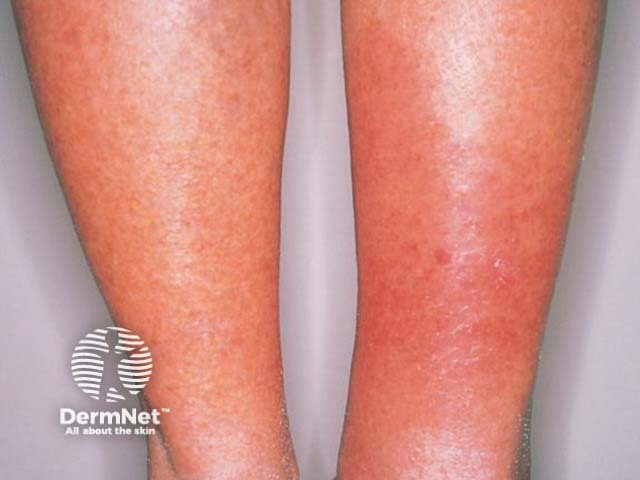Main menu
Common skin conditions

NEWS
Join DermNet PRO
Read more
Quick links
Mixed diagnoses – 10 cases (11 of 11)
For each of the ten cases, study the image and then answer the questions. You can click on the image to view a larger version if required.
Each case should take approximately five minutes to complete. There is a list of suggested further reading material at the end of the quiz.
When you finish the quiz, you can download a certificate.
Case 6

What is the diagnosis?
The patient has acute cellulitis, most likely due to Streptococcus pyogenes. Other non-group A streptococci or other organisms are possible.
What investigations should be done, if any?
A swab for microscopy and culture from the affected skin may identify the causative organism, which may also be found between the toes. A marginally more reliable method is to inject 0.5ml normal saline into the affected area, and aspirate tissue fluid. This can be stained by direct immunofluorescence for antibodies to Streptococcus pyogenes. Blood cultures can be helpful. Other tests will depend on the clinical presentation and underlying disease, e.g. diabetes.
What is the management?
Rest and elevation of the affected part are important. Oral antibiotics for streptococcal infections, e.g. penicillin, should be prescribed in reasonably high dose. If the presentation is atypical, or the patient very unwell, they may be combined with broad-spectrum cover of staphylococci and gram negative organisms until culture results are available. Penicillin-allergic patients may be treated with erythromycin, clindamycin or a first generation cephalosporin.
If there has been little response to oral antibiotics within 24 hours, or the patient is sick, admit for intravenous antibiotics and bed rest.
Examine the feet for a source of infection, and culture for bacteria and fungi. Treat eczema, athlete's foot etc. vigorously.
Recurrent cellulitis may require a prolonged course of oral antibiotics. Persistent leg oedema should be actively managed with elevation, and compression hosiery.
